Herford, a town in the lowlands of northern Germany, is the home of T+A Elektroakustik. T+A -- aka Theory and Application in the Field of Audio Technology -- is an engineering- and science-based, family-owned and -operated business that has been designing and building audio equipment in Germany since 1978, and collaborates with universities and technical schools in the design of powered speakers and digital signal processing (DSP). Other than the music itself, their current product lines include just about everything required for the reproduction of two-channel audio: turntables, media players, disc players, DACs, amplifiers, integrated amplifiers, loudspeakers, interconnects, speaker cables, power cords, and power strips.
Series 8 is T+A’s lowest-priced line, and for the last few weeks my listening room has hosted the DAC 8 DSD digital-to-analog converter ($4450 USD) and the MP 8 CD-player/streamer/tuner ($4750, review forthcoming). The only Series 8 model missing was the Amp 8 stereo power amplifier ($3150). This former student of physics and electronics was drawn to T+A’s engineering-minded design philosophy, while this modest musician and lover of music hoped that the DAC 8 DSD’s reproduction of my recordings would prove true to the sources.
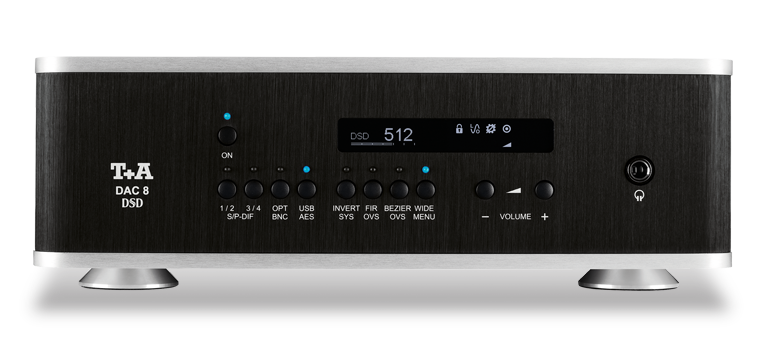
Description
The DAC 8 DSD feels European to me because of its size. All three 8-series models have the same square footprint of 10.7”W x 10.7”D and are 3.8”H. The DAC 8 weighs 8.9 pounds and sits on attractive feet in the shape of truncated cones. Its front and side panels are made of seamless, black brushed aluminum tied together by a matching rear panel. The thick top and bottom plates are of brushed silver aluminum, and are attached to the rest of the chassis at its four rounded corners with countersunk, chromed machine screws. Everything about the build of the DAC 8 DSD shouts high-precision machining and small tolerances, right down to the tiny, highly polished band at the bottom of each of the feet -- the gaps between and overlap of panels are essentially nonexistent. I love the contrast of silver and black, brushed and chromed, and the subtly but distinctly colored indicators.
The layout of the front panel is precise and simple, though the short and long pressings of buttons required to access some features might take some getting used to. A small T+A logo and the model name appear at far left, and at right is a headphone jack that cuts the signal at the analog outputs when headphones are plugged in. Between these are the On button and a high-quality white OLED display, and below those is a row of eight buttons. The first four buttons are for the DAC 8’s inputs: the first two select among the four RCA coaxial S/PDIF inputs, the third toggles between TosLink optical and BNC, and the fourth between USB and AES/EBU XLR. The next quartet of buttons control the DAC 8’s extensive settings options: Invert Syst (invert signal polarity), FIR Ovs (select one of two levels of FIR oversampling), Bezier Ovs (two levels of Bezier oversampling), and Wide Menu (select an analog filter with Normal or Wide output bandwidth). The user also has control over: balance, display brightness, DSD rate and sampling rate, and volume-display options of step number or level in -dB. The two buttons for Volume Up/Down control the DAC 8’s analog-domain volume control -- unless the line-level output setting is selected on the rear panel, for use with a separate preamplifier. All settings could be adjusted from the comfort of my listening chair with the included FM8 remote control, which is made of aluminum and feels bespoke. The remote is nicely weighted, with rounded sides and raised rubber buttons; I found it easy to use.
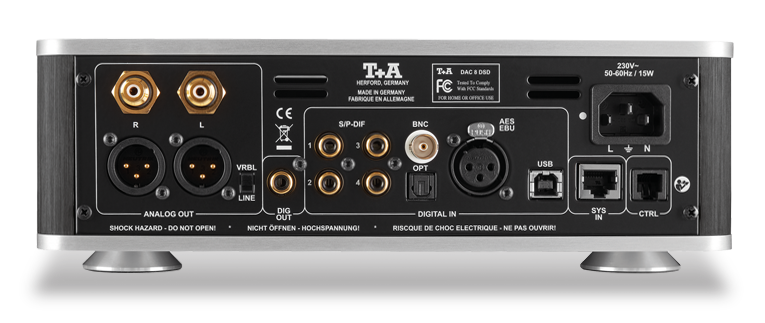
The connectivity on the rear panel is straightforward. Starting at the left, there are balanced (XLR) and single-ended (RCA) analog outputs, with a slider switch for selecting between variable and fixed line-level output. A single RCA-based S/PDIF digital output is followed by eight digital inputs: four RCA and one BNC (all up to 24-bit/192kHz), TosLink (up to 24/96), XLR (up to 24/192), and USB (up to 32/384 LPCM and DSD 64/128/256/512, DSD256 and DSD512 available only via a Windows PC with appropriate driver). There are also two system ports: Sys In (Ethernet), for communication with T+A’s MP 8 player, and Ctrl (RS-232), for an automated system controller. Finally, there’s an IEC power inlet. All ports and connectors had tight, precise fits and felt of high quality.
The DAC 8 DSD performs upsampling via a custom-programmed DSP chip with four filtering options. The two FIR filters have high linearity and damping but add some pre- and post-ringing to the signal. The long FIR1 filter is an industry-standard oversampling filter, while the lower-coefficient, short FIR2 filter reduces time-range errors, while also including a modest reduction in linearity and damping. The two Bezier filters are T+A’s own variations on a Bezier curve. T+A describes Bez1 as a “Bezier interpolator combined with an IIR filter,” and claims that it eliminates the pre-ringing associated with FIR filtering and produces sound similar to that of a high-quality record player. Bez2 is a pure Bezier interpolator that eliminates both pre- and post-ringing and introduces zero timing errors, purportedly resulting in a sound with, per T+A, “an impressive blend of naturalness, good dynamics and accuracy.”
What’s exciting about the DAC 8 DSD’s design is that it offers two discrete signal paths. T+A describes its PCM path as a “Double-Differential-Quadruple-Converter” with four 32-bit delta-sigma D/A converters per channel; it oversamples signals up to 384kHz. But rather than use a single multibit PCM DAC and an algorithm to process DSD signals, T+A built a separate, 1-bit DAC to keep the DSD signal pure. Switching between PCM and DSD is automatic. If your playlist includes content in both formats, there is a slight delay as the DAC 8 detects that the format has changed, and its relays switch the data to the appropriate converter.
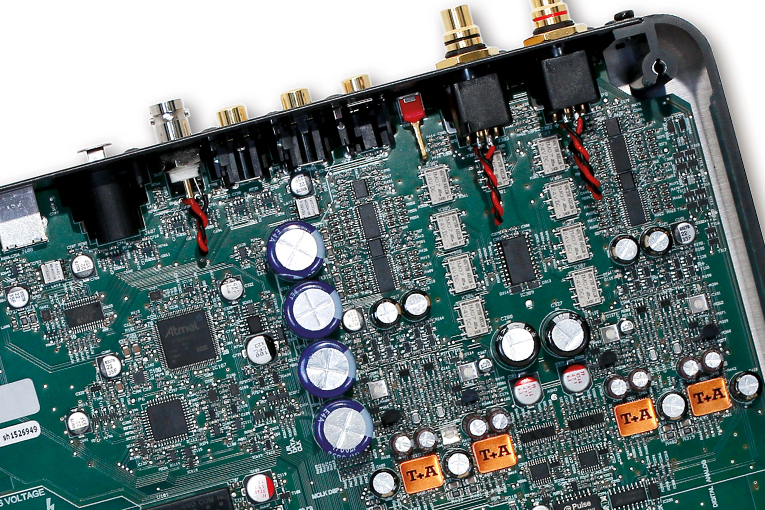
After the digital signal has been converted to analog, T+A offers another option. The DAC 8 DSD’s analog output filtering includes a Clean mode that permits the analog output to run up to 60kHz, and a Wide mode that lets the analog output include high frequencies up to 120kHz, for those whose amplifiers can properly pass along signals up to 300kHz. T+A says that the simple test of your amp’s bandwidth is to run the Wide filter and listen for a difference in sound. If you hear one, keep the DAC 8 set to Wide, so that you get the best-quality output utilizing the full spectrum of frequencies produced by the T+A. If you hear no difference, set it to Clean, which tailors the output signal to your amplifier’s abilities.
The DAC 8 DSD's power consumption is fairly low: 0.3W in standby, 15W maximum -- it never got warm during use -- and it automatically shuts itself off when it hasn’t received an audio signal for 90 minutes. The DAC 8 has separate power supplies for its digital and analog circuits, and uses galvanic isolation to further limit any unwanted interaction between the two sections. Its total harmonic distortion is specified as less than 0.003%, its signal/noise ratio as 116dB.
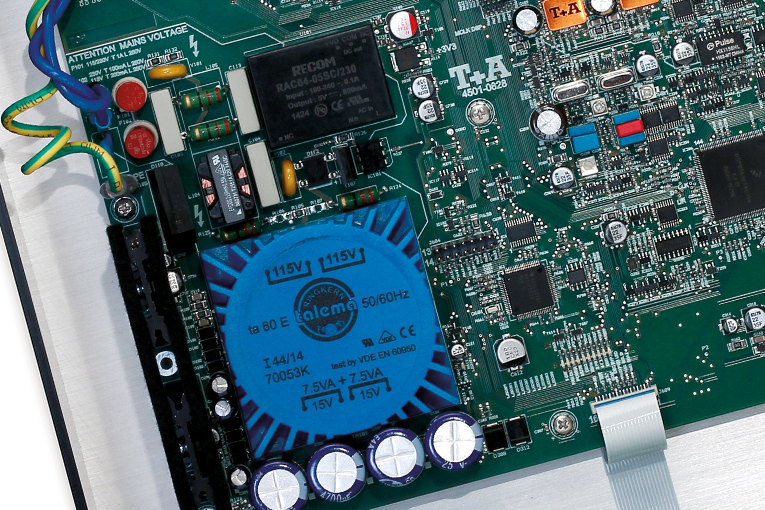
Setup
The T+A DAC 8 DSD’s many abilities mean that it can be added to a system in a variety of ways, depending on the user’s needs. During its time here, I sent the DAC 8 music from iTunes, Tidal, and Roon from the Apple iMac I use as a server. The computer automatically detected the DAC 8 DSD as soon as the two were connected with a Nordost Blue Heaven LS USB link; I selected it as the output, and the computer sent it music signals. PCs will probably require the downloading and installation of the appropriate drivers from T+A’s website. Most of my listening was done with the DAC 8’s balanced outputs set to variable and connected directly to my Audio Research D300 amplifier with Dynamique Audio’s Shadow XLR interconnects. Thereafter, the analog signal continued to my KEF R900 loudspeakers through Transparent Audio’s MusicWave Ultra speaker cables. Headphone listening was identical to the full setup, but with output from the front-panel headphone jack sent to my NAD Viso HP50 headphones. I did all of my listening through the DAC 8’s Bez2 digital filter with Clean analog output.
An alternate setup was needed to provide a comparison with Schiit Audio’s Yggdrasil DAC with Analog 2 upgrade, because the Yggy lacks a variable output. I matched the system used for the Yggy by adding my Hegel Music Systems P20 preamplifier, and another set of Dynamique Shadow interconnects (XLR) between the DAC 8 DSD (its analog output now set to line level) and the ARC amp.
Listening
The DAC 8 DSD produced enormous soundstages that often extended well past the outer boundaries of the speakers and sometimes seemed bigger than my listening room. I discovered a huge space in every track of Erasure’s Cowboy (16-bit/44.1kHz AIFF, Maverick), and ended up listening to the entire album. In “Rapture,” Erasure’s cover of the Blondie hit from 1980, the notes of the spacey synthesizer intro appear all over the soundstage. The DAC 8 demonstrated terrific width of soundstage by placing some of these notes beyond the speakers’ outer baffles, as well as at various heights between the speakers, above and below the height of the tweeters. The position in space of each note was precise. Then, when the main melody begins, the sound of the band filled the stage, with an excellent balance of the various voices and synthesized instruments. Despite the complexity of the arrangement, nothing predominated until the lead vocal and rap were highlighted at center stage. As each new electronic instrument entered -- especially the clanging tubular bells -- it was clear and distinct, and contrasted with the smoothness of the underlying bass track.
I then played Blondie’s original version of “Rapture,” from my 1989 copy of The Best of Blondie (16/44.1 AIFF, Chrysalis). It sounded laid-back in comparison with the fairly forward sound of Erasure’s cover. In addition to my feeling that the band was set well back from the plane described by my speakers’ baffles, everything about the recording felt much smaller and closed in. The only exceptions were the handclaps emanating directly from the left and right speakers. The mix sounded a little disjointed. From these two very different recordings of the same song in very different types of sound, I concluded that the DAC 8 DSD was itself quite neutral, with the ability to allow each recording to set its own space.
In Blondie’s version of “Rapture,” Debbie Harry’s lead vocal has hints of sibilance but, like the soundstage, this was more a reflection of the recording than of the DAC 8 DSD’s reproduction of high frequencies. Her voice was not bright or overemphasized, and was portrayed with an organic sense of timbre. Harry sings verse endings in a lower tone that conveyed a sense of strength that the DAC 8 DSD convincingly reproduced. I could almost sense Harry relaxing and widening her throat to generate her richness and power. Finally, the rap portion of the song retained a fairly warm, spoken-word feel to it. Through the T+A, Harry sounded as natural and musical as I’ve heard her, considering that this track was recorded in 1980.
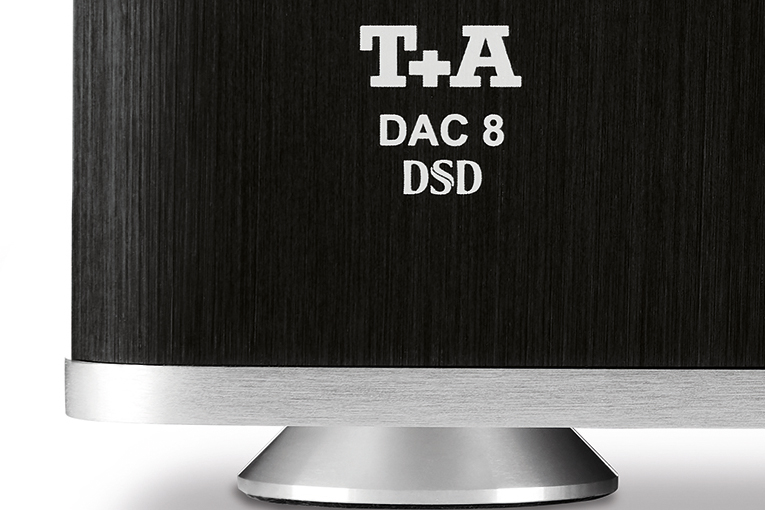
“Connection,” from Sean Paul’s The Trinity (16/44.1 AIFF, Atlantic), features a hard-hitting, uniform bass line that runs the length of the track. The slam of this bass line is highly emphasized in the recording, but is conspicuous not due to this emphasis but because of its clarity and definition, with a sharply delineated attack and decay. Through the DAC 8 DSD, its visceral impact line was remarkable. By contrast, the DAC 8 DSD didn’t lose track of the subtle nuances in the singing of the accompanying vocal duo, Nina Sky (identical twins Natalie and Nicole Albino). Their voices have a quiet, breathy character that the DAC 8 portrayed with tremendous detail, exposing a mild vibrato and a bit more airiness than I’d previously heard from this recording. The detail gave more weight to the undertone of vulnerability in the sisters’ singing, adding to the emotional content of this performance. Sean Paul’s vocal fell between the Albinos’ and the pumping bass, strongly masculine and tenor-like in tone, his words sounding crisp in their delivery. The DAC 8 DSD reproduced transients and high-frequency detail with extreme resolution while remaining musical and never editorializing.
Thus far, my music selections had been my own CDs ripped to AIFF files and converted using the DAC 8 DSD’s multibit PCM DAC. Curious about how the same recording would fare through the T+A’s discrete PCM and DSD circuits, I tried the DSD128 and FLAC 24/176 versions of the first movement of Mozart’s Violin Concerto No.4, K.218, performed by violinist Marianne Thorsen and the Trondheim Soloists, from Norwegian label 2L. I felt I could sense real musicians playing, rather than just the naked sound of their instruments -- as if I could see Thorsen’s bow skipping across the low strings and gliding more smoothly across the higher strings. Both hi-rez versions felt richer in such detail than their 16/44.1 counterpart. The soundstages of all three were of similar size, but the hi-rez sound was tonally denser and more palpable, with better stereo imaging, and greater separation of instruments.
The DSD128 and PCM 24/176 versions both sounded superb, but did they sound superb in different ways through the T+A? A little. The PCM version was a bit brighter, with slightly more eager strings and a tipped-up treble. The DSD version was bit more bass heavy in the brass and cellos and double basses. A matter of taste.
The DAC 8 DSD’s headphone amp provided me with rewarding listening sessions. Its frequency response was fairly flat, though the bass was emphasized a bit more than I prefer -- the Erasure recording sounded a touch too bass-heavy for a light electronic pop band, though the bassy sound perfectly suited the Sean Paul track. Female voices, such as those of Debbie Harry and Nina Sky, were compellingly unvarnished in their reproduction, and the T+A headphone amp’s reproduction of the treble was squeaky clean. I didn’t spend much time listening to the DAC 8 through headphones, but enough to say that its headphone output is no afterthought.
Comparison
I wanted to compare the abilities of the T+A DAC 8 DSD with those of my Benchmark Music Systems DAC2 HGC ($1995) -- because both have lots of digital inputs and built-in analog volume controls, and can process DSD signals, they can be used in exactly the same way. I was also interested to hear how the T+A would sound next to the giant-killing sound quality of Schiit Audio’s Yggdrasil DAC ($2399).
The Benchmark DAC2 HGC has two line-level analog inputs, the DAC 8 DSD does not. With a similar feature set at less than half the DAC 8 DSD’s price ($4450), the Benchmark is a high-value modern DAC. The Benchmark falls behind in lacking PCM oversampling filter options and a discrete DSD DAC -- the DAC2’s ESS Technology Sabre chipset converts PCM and DSD signals. The sound of the Benchmark was similar to the T+A’s with the latter’s standard FIR1 filter engaged, but when I set the DAC 8 DSD to my preference, the Bez2 filter, there were significant differences. The Benchmark’s bass was less impactful than the T+A’s, and Sean Paul’s “Connection” and Erasure’s cover of “Rapture” had less slam. Further, the power of the voices of Debbie Harry and the Nina Sky duo was attenuated through the DAC2 compared to the DAC 8 DSD’s more robust, vibrant sound, while through the Benchmark Harry’s voice sounded less fleshed-out, with less depth. Unlike with the T+A, I heard no difference between the DSD and PCM hi-rez versions of the Mozart violin concerto. Overall, the Benchmark sounded thinner and more mechanical than the T+A’s more musical, more fully embodied sound, regardless of which format I played.
Schiit’s Yggdrasil jumped in with a more competitive sound but a feature set well short of the T+A’s or the Benchmark’s. The Yggy needs a preamp -- it has no volume control -- can’t process DSD, and offers no alternative digital filters beyond their custom one. I restored to the system my Hegel P20 preamp, set the output of the DAC 8 DSD to line level, and listened for differences. The ultimate resolution of the DAC 8 was reduced by the additional analog processing, with now a slight softness to the sound. The Schiit provided a much more musical sound than the Benchmark, sounding far more like the T+A with Bez2 filter engaged. The Yggy had a wider but shallower soundstage than the DAC 8 DSD, Harry’s voice sounding a bit narrower and set farther back in the soundstage, making the Schiit sound more laid-back in comparison. Female voices sounded similar through the Schiit and T+A, and both DACs produced well-defined, three-dimensional central aural images. Both also offered similar levels of bass impact, the Yggy more than able to keep up with the T+A’s pace and timing. The clarity of both DACs’ sound was high, as was their sense of musicality. Still, the Schiit offers no choice of digital filter and can’t play DSD, and requires a traditional preamp to remain in the signal chain. With the almost-twice-as-expensive T+A DAC, you get what you pay for.
Conclusion
T+A Elektroakustik’s philosophy of high science and engineering, as evidenced in their most reasonably priced DAC, has resulted in a highly capable and flexible audio component built to an exacting standard. With its excellent soundstaging, clear imaging, and neutral overall sound, the DAC 8 DSD is an accomplished modern DAC. It can also fit into any digital music listener’s system and favor by virtue of its multitude of digital inputs, digital and analog filtering options, and its ability to decode PCM and DSD signals via independent DAC circuits. Science and engineering can exist in the service of music!
. . . Erich Wetzel
erichw@soundstagenetwork.com
Associated Equipment
- Loudspeakers -- KEF R900
- Preamplifier -- Hegel Music Systems P20
- Amplifier -- Audio Research D300
- Sources -- Apple iMac running Mac OS 10.11.6, iTunes, Tidal music-streaming service, Roon
- Headphones -- NAD Viso HP50
- Digital-to-analog converters -- Benchmark Media Systems DAC2 HGC, Schiit Audio Yggdrasil with Analog 2 upgrade
- Speaker cables -- Transparent Audio MusicWave Ultra
- Analog interconnects -- Dynamique Audio Shadow XLR, Transparent Audio MusicLink Super RCA
- USB Cable -- Nordost Blue Heaven LS
T+A Elektroakustik DAC 8 DSD D/A Converter
Price: $4450 USD.
Warranty: Two years parts and labor.
T+A Elektroakustik GmbH & Co. KG
Planckstrasse 9-11
D-32052 Herford
Germany
Phone: +49 (0) 5221-7676-0
Website: www.ta-hifi.de






















